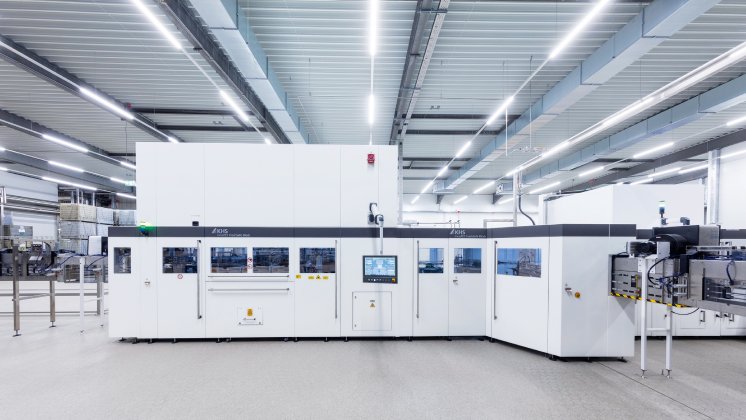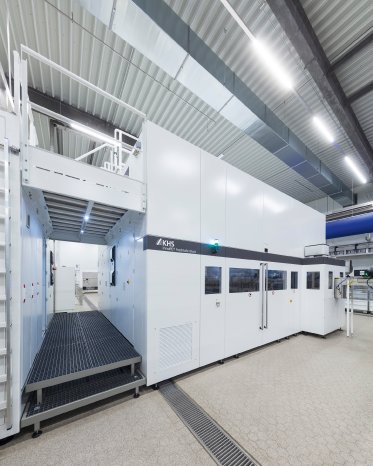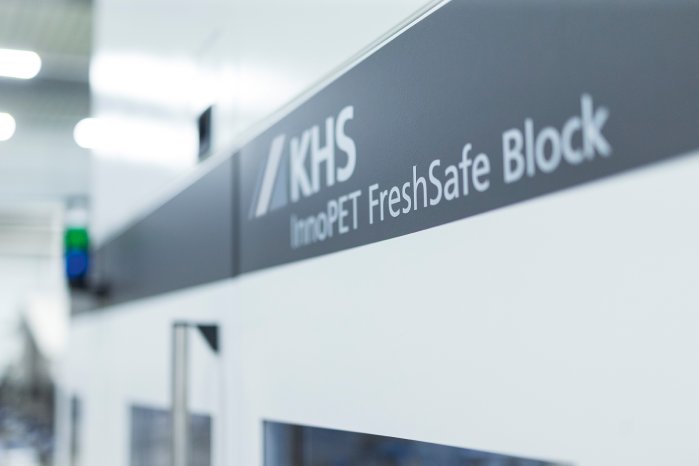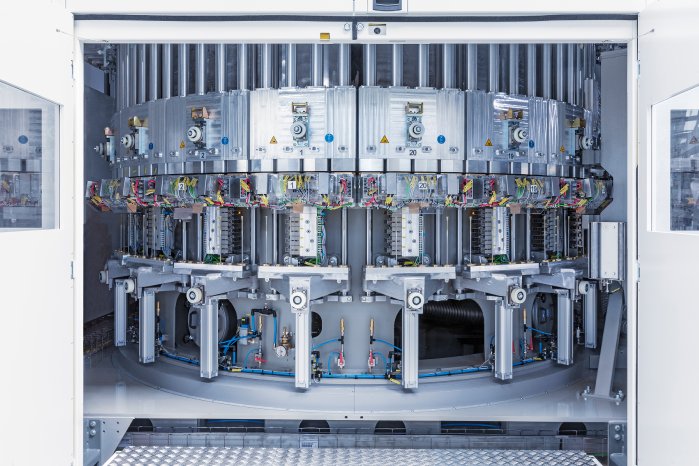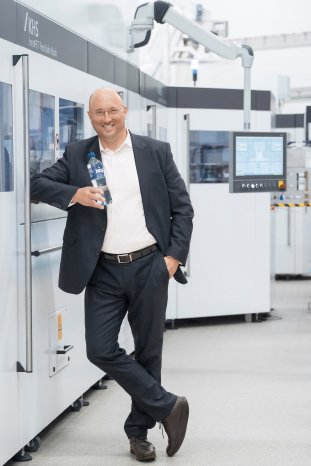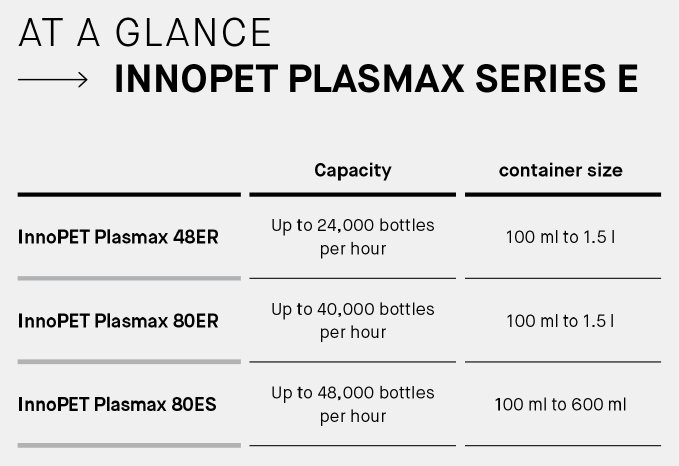The only plastic bottle to date to combine highly effective product protection with 100% recyclability by material type is manufactured using a revolutionary coating technology that KHS launched to market around 20 years ago. Much persuasion was needed before the beverage industry finally jumped on this bandwagon in its increasing move towards sustainability and requirement for circular packaging. The effort was worth it: in the meantime, a number of national and international bottlers now rely on this technology, prompting the systems provider to increase its capacities at KHS’ Hamburg production site to meet the growing demand.
This success story is rooted in the method of coating the insides of PET bottles with a wafer-thin layer of chemically pure glass that protects the content against oxygen pickup and carbon dioxide loss. This both retains the flavor and extends the shelf life – similar to a glass bottle yet with the lower weight and greater robustness of a plastic container.
Food safety established
The concept of barrier technology isn’t new. However, the competition uses blended or multilayer materials which make later bottle-to-bottle recycling to produce pure PET recyclate difficult to impossible. The composite materials can barely be separated from one another and form a jumble of secondary raw materials and chemical compounds. KHS’ FreshSafe PET coating system is different: here, the interior coating can be completely washed off during the recycling process, thus permitting full bottle-to-bottle reuse. This has been confirmed by both the EPBP (European PET Bottle Platform) and North America’s APR (Association of Plastic Recyclers). The container’s suitability for use with foods has also been officially established by the US Food and Drug Administration (FDA) and most recently by safety certification issued by the Chinese National Health Commission, among other institutions.
Over the years KHS has continuously improved the new technology and now taken it to the next level with its current further development. The two key objectives were to increase capacity on the one hand and boost efficiency on the other.
Alternative capacity ranges
Thanks to the further developed generation of machines that replaces the previous 20Q and 20L series, PET bottles can be coated at an output of up to 48,000 an hour on the InnoPET Plasmax 80ES variant. The very first latest-generation Plasmax machine is installed at the VILSA mineral water bottling plant in Germany (see the box entitled “Three questions for ...”).
The higher capacity is the result of improvements to the process realized by the KHS experts. On the FreshSafe PET TriBlock, for instance, the infeed and discharge for the coating machine have now been placed at the same height as those on the stretch blow molder and filler. This means that the lifting wheel that formerly had to transport the containers 30 centimeters up to the coating module is no longer required. Bottle handling has also been simplified and made even more robust – all in preparation for the even higher speeds forecast by Philipp Langhammer, product manager for barrier technology at KHS. “By moving up into the higher capacity ranges we want to reach out to the big bottlers of carbonated soft drinks in particular who need to protect their beverages against carbon dioxide loss in smaller bottles especially,” he states. “After all, the smaller the container volume, the larger the surface area in relation to this. Accordingly, the risk increases of carbon dioxide escaping or oxygen being picked up through the plastic bottle wall.”
Individual customer requirements
The modular machine platform can be configured for very different speeds in accordance with individual customer requirements. From the beginning of 2025, the InnoPET Plasmax 48ER will be available for niche suppliers, smaller bottlers or converters who are more interested in a low to medium output. This version can coat a maximum of 24,000 bottles per hour.
Besides offering various capacity ranges, great value was also attached to more flexibility for operators. For startups who market both sensitive products and those that don’t require any additional product protection, for example, KHS has equipped the block with a bypass wheel. This ensures that the relevant bottles are transported from the stretch blow molder past the coating module directly to the filler.
Higher evacuation capacity
With respect to the coating process itself, the further development primarily scores with its higher evacuation capacity: this lowers the demand for container vacuum stability. This in turn yields savings in PET lightweighting. “A customer who until recently needed a PET bottle weighing 22 grams for a storage period of 100 days can now cut the weight down to just 14 grams using the latest FreshSafe PET coating technology – while doubling the shelf life at the same time,” calculates Langhammer. “For beverage fillers who need to produce products for the high season in advance, this has two advantages: one, they can save up to a third in plastic, and two, fewer beverages have to be thrown away because they’ve passed their best-before date.”
Further boost in efficiency
Significant optimizations have also been made with regard to boosting efficiency. “The key new features here are the creation of a shared modular platform and a reduction in the complexity of parts, components and maintenance tasks,” Langhammer explains. “This means that as many identical parts as possible are used for the different capacity ranges.”
The new InnoPET Plasmax machine generation’s improved and more flexible layout plus a smaller footprint also make the block easier to integrate into the production area. On the one hand, the machine depth has been reduced by 25%; on the other, the stretch blow molder, coating module and filler can be arranged in an L, U or V shape in the bottling shop depending on the space available.
Lower maintenance costs
Besides higher outputs, even better coating quality and more flexibility, the new series gives beverage producers a sound economic advantage when it comes to operating costs. “We’ve managed to lower maintenance costs”, smiles Langhammer. “This is of course an important criterion when deciding to invest in our plant engineering.” One improvement based on the proven technology is easier access to all process gas valves. The new design of the lance carrier system saves on pistons and therefore reduces the number of seals and subsequently the cost and effort of servicing. Finally, a new vacuum pump also helps to cut costs. “Thanks to the further improved service lives of our maintenance parts, we can also lengthen maintenance intervals,” Langhammer concludes.
Three questions for Henning Rodekohr,
managing partner of the VILSA Group which was the first German mineral water producer to opt for KHS’ innovative product protection. The very first InnoPET FreshSafe block of the latest Plasmax generation is installed at the group’s bottling plant in Bruchhausen-Vilsen in Lower Saxony.
What significance does sustainability hold for VILSA?
As a mineral water bottling plant we owe a lot to our natural environment and would like to give something back in return. Protecting our springs in the long term is thus a key issue for us. Our organic mineral water certification and our pledge to develop science-based climate goals according to the net zero standard of the Science-Based Targets initiative (SBTi) ensure that we keep to the strictest threshold values and uphold the highest sustainability standards commonly applied on the German mineral water market.
Why do you use Plasmax barrier technology for your mineral water?
Our consumers rely on the fact that in VILSA they get a naturally pure, premium product. In order to live up to this claim, we have to effectively protect our valuable product from outside influences and reliably safeguard its taste. We therefore depend on packaging that combines maximum sustainability standards with the best possible product protection.
To what extent does Plasmax also have you convinced with respect to sustainability?
All of our non-returnable bottles consist of 100% recycled and recyclable PET. It’s thus only logical that we use a barrier technology to protect our products that not only provides the best protection properties but also continues to permit full recycling by material type.
